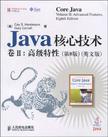Java核心技术 卷Ⅱ
出版时间:2009-9 出版社:人民邮电出版社 作者:(美)霍斯特曼(Horstmann,C.S.),(美)科奈尔 页数:1032
Tag标签:无
前言
致读者 本书按照Java SE 6对上一版本进行了完全更新。卷I主要介绍了Java语言的一些关键特性,而本卷主要介绍程序员进行专业软件开发时需要了解的高级主题。因此,与卷I以及本书以前的版本一样,我们仍将其定位于面对将Java技术运用于实际项目的编程人员。 请注意,如果你是经验丰富的程序员,能够灵活运用内部类和泛型等高级语言特性,就没有必要在阅读完卷I的基础上再从本卷获益。不过,本卷会根据适当情况去参考引用卷I的有关内容(当然,我们希望你或者已经购买了卷I),你也可以在任何一本综合介绍1ava平台的书中获取所需的背景知识。 任何一本书都难免会存在一些错误和不妥。我们非常希望读者将在本书中找到的错误和不妥通报给我们。当然,我们更希望只收到一次出现这些问题的报告。为此,我们创建了一个FAQ、bug修正以及应急方案的网站Http://horstmann.com/corejava。可以在bug报告页面(该页面的目的是鼓励读者阅读以前的报告)的末尾处添加bug报告,以便发布bug和问题、给出建议,从而改进本书的未来版本。 本书内容 本书中的章节大部分是相互独立的。你可以研究任何感兴趣的主题,也可以按照任意顺序阅读这些章节。 第1章介绍输入输出处理。在Java中,所有I/O都是通过所谓的“流”来处理的。流使你可以按照统一的方式来处理各种数据源之间的通信,如文件、网络连接或内存块。本章详细介绍了各种读入器和写出器类,它们使得对Unicode的处理更容易;还介绍了在使用对象序列化机制从而使保存和加载对象变得容易而方便时,其背后的原理是什么。最后,讨论了支持高效文件操作的“新I/0”类(它们曾作为最新内容添加到Java SE 1.4中)和正则表达式类库。
内容概要
《Java核心技术 卷2:高级特性(第8版)(英文版)》内容全面丰富,覆盖了Java技术的所有高级主题,主要包括流与文件、XML、网络、数据库编程、高级Swing、高级AWT、JavaBean构件、安全、分布式对象、脚本、编译与注解处理,还介绍了本地化、国际化以及Java SE 6等内容。《Java核心技术 卷2:高级特性(第8版)(英文版)》讲解深入透彻,在上一版的基础上对JDK 6.0中的新特性进行了重点介绍,并包含大量示例,所有示例代码都对应Java SE 6进行了全面更新。 《Java核心技术 卷2:高级特性(第8版)(英文版)》可帮助读者充分理解Java语言和Java类库的相关特性,主要针对将Java技术运用于实际项目的编程人员。
作者简介
Cay S.Horstmann是Core JavaServer Faces,Second Edition一书的作者之一。Cay是San Jose州立大学计算机科学系的教授,Java的支持者,也是活跃于计算机业界会议的演讲者。 Gary COrnell编写编程技术方面的书籍并教授相关知识已有20多年。是Apress的创始人之一。他编写了许多有关编程技术方面的畅销书。曾获Jolt大奖。还赢得了Visual Basic Magazine Readers Choice大奖。
书籍目录
1 STREAMS AND FILESStreamsReading and Writing BytesThe Complete Stream ZooCombining Stream FiltersText Input and OutputHow to Write Text OutputHow to Read Text InputSaving Objects in Text FormatCharacter SetsReading and Writing Binary DataRandom-Access FilesZIP ArchivesObject Streams and SerializationUnderstanding the Object Serialization File FormatModifying the Default Serialization MechanismSerializing Singletons and Typesafe EnumerationsVersioningUsing Serialization for CloningFile ManagementNew I/OMemory-Mapped FilesThe Buffer Data StructureFile LockingRegular Expressions2 XMLIntroducing XMLThe Structure of an XML DocumentParsing an XML DocumentValidating XML DocumentsDocument Type DefinitionsXML SchemaA Practical ExampleLocating Information with XPathUsing NamespacesStreaming ParsersUsing the SAX ParserUsing the StAX ParserGenerating XML DocumentsWriting an XML Document with StAXXSL Transformations3 NETWORKINGConnecting to a ServerSocket TimeoutsInternet AddressesImplementing ServersServing Multiple ClientsHalf-CloseInterruptible SocketsSending E-MailMaking URL ConnectionsURLs and URIsUsing a URLConnection to Retrieve InformationPosting Form Data4 DATABASE PROGRAMMINGThe Design of JDBCJDBC Driver TypesTypical Uses of JDBCThe Structured Query LanguageJDBC ConfigurationDatabase URLsDriver JAR FilesStarting the DatabaseRegistering the Driver ClassConnecting to the DatabaseExecuting SQL StatementsManaging Connections, Statements, and Result SetsAnalyzing SQL ExceptionsPopulating a DatabaseQuery ExecutionPrepared StatementsReading and Writing LOBsSQL EscapesMultiple ResultsRetrieving Autogenerated KeysScrollable and Updatable Result SetsScrollable Result SetsUpdatable Result SetsRow SetsCached Row SetsMetadataTransactionsSave PointsBatch UpdatesAdvanced SQL TypesConnection Management in Web and Enterprise ApplicationsIntroduction to LDAPConfiguring an LDAP ServerAccessing LDAP Directory Information5 INTERNATIONALIZATIONLocalesNumber FormatsCurrenciesDate and TimeCollationCollation StrengthDecompositionMessage FormattingChoice FormatsText Files and Character SetsCharacter Encoding of Source FilesResource BundlesLocating Resource BundlesProperty FilesBundle ClassesA Complete Example6 ADVANCED SWINGListsThe JList ComponentList ModelsInserting and Removing ValuesRendering ValuesTablesA Simple Table 370 Table ModelsWorking with Rows and ColumnsCell Rendering and EditingTrees 405 Simple TreesNode EnumerationRendering NodesListening to Tree EventsCustom Tree ModelsText ComponentsChange Tracking in Text ComponentsFormatted Input FieldsThe JSpinner ComponentDisplaying HTML with the JEditorPaneProgress IndicatorsProgress BarsProgress MonitorsMonitoring the Progress of Input StreamsComponent OrganizersSplit PanesTabbed PanesDesktop Panes and Internal FramesCascading and TilingVetoing Property Settings7 ADVANCED AWTThe Rendering PipelineShapesUsing the Shape ClassesAreasStrokesPaintCoordinate TransformationsClippingTransparency and CompositionRendering HintsReaders and Writers for ImagesObtaining Readers and Writers for Image File TypesReading and Writing Files with Multiple ImagesImage ManipulationConstructing Raster ImagesFiltering ImagesPrintingGraphics PrintingMultiple-Page PrintingPrint PreviewPrint ServicesStream Print ServicesPrinting AttributesThe ClipboardClasses and Interfaces for Data TransferTransferring TextThe Transferable Interface and Data FlavorsBuilding an Image TransferableTransferring Java Objects via the System ClipboardUsing a Local Clipboard to Transfer Object ReferencesDrag and DropData Transfer Support in SwingDrag SourcesDrop TargetsPlatform IntegrationSplash ScreensLaunching Desktop ApplicationsThe System Tray8 JAVABEANS COMPONENTSWhy Beans?The Bean-Writing ProcessUsing Beans to Build an ApplicationPackaging Beans in JAR FilesComposing Beans in a Builder EnvironmentNaming Patterns for Bean Properties and EventsBean Property TypesSimple PropertiesIndexed PropertiesBound PropertiesConstrained PropertiesBeanInfo ClassesProperty EditorsWriting Property EditorsCustomizersWriting a Customizer ClassJavaBeans PersistenceUsing JavaBeans Persistence for Arbitrary DataA Complete Example for JavaBeans Persistence9 SECURITYClass LoadersThe Class Loader HierarchyUsing Class Loaders as NamespacesWriting Your Own Class LoaderBytecode VerificationSecurity Managers and PermissionsJava Platform SecuritySecurity Policy FilesCustom PermissionsImplementation of a Permission ClassUser AuthenticationJAAS Login ModulesDigital SignaturesMessage DigestsMessage SigningThe X.Certificate FormatVerifying a SignatureThe Authentication ProblemCertificate SigningCertificate RequestsCode SigningJAR File SigningSoftware Developer CertificatesEncryptionSymmetric CiphersKey GenerationCipher StreamsPublic Key Ciphers10 DISTRIBUTED OBJECTSThe Roles of Client and ServerRemote Method CallsStubs and Parameter MarshallingThe RMI Programming ModelInterfaces and ImplementationsThe RMI RegistryDeploying the ProgramLogging RMI ActivityParameters and Return Values in Remote MethodsTransferring Remote ObjectsTransferring Nonremote ObjectsDynamic Class LoadingRemote References with Multiple InterfacesRemote Objects and the equals, hashCode, and clone MethodsRemote Object ActivationWeb Services and JAX-WSUsing JAX-WSA Web Service ClientThe Amazon E-Commerce Service11 SCRIPTING, COMPILING, AND ANNOTATION PROCESSINGScripting for the Java PlatformGetting a Scripting EngineScript Evaluation and BindingsRedirecting Input and OutputCalling Scripting Functions and MethodsCompiling a ScriptAn Example: Scripting GUI EventsThe Compiler APICompiling the Easy WayUsing Compilation TasksAn Example: Dynamic Java Code GenerationUsing AnnotationsAn Example: Annotating Event HandlersAnnotation SyntaxStandard AnnotationsAnnotations for CompilationAnnotations for Managing ResourcesMeta-AnnotationsSource-Level Annotation ProcessingBytecode EngineeringModifying Bytecodes at Load Time12 NATIVE METHODSCalling a C Function from a Java ProgramNumeric Parameters and Return ValuesUsing printf for Formatting NumbersString ParametersAccessing FieldsAccessing Instance FieldsAccessing Static FieldsEncoding SignaturesCalling Java MethodsInstance MethodsStatic MethodsConstructorsAlternative Method InvocationsAccessing Array ElementsHandling ErrorsUsing the Invocation APIA Complete Example: Accessing the Windows RegistryOverview of the Windows RegistryA Java Platform Interface for Accessing the RegistryImplementation of Registry Access Functions as Native MethodsIndex
编辑推荐
《Java核心技术 卷2:高级特性(第8版)(英文版)》是Core Java,Volume//: Advanced Features的最新版本,主要介绍Java SE 6平台的高级用户界面设计和企业特性等内容。书中精心安排的示例程序用于演示最新的编程技术,并针对专业开发者在现实中遇到的问题提供最佳解决方案。 关于Java基础知识的介绍,包括接口与内部类、使用Swjng的GUI编程、异常处理、泛型、集合和并发等内容,可参阅《Java核心技术卷I:基础知识(第8版)》。
图书封面
图书标签Tags
无
评论、评分、阅读与下载
用户评论 (总计9条)
- 博学,审问、慎思、明辨、笃行
读实用书时要提出的四个问题:
(1)整体来说,这本书到底在谈些什么?big what? 并没有改变多少。
(2)作者细部说了什么,怎么说的? small what? how?
(3)这本书说得有道理吗? 是全部有道理,还是部分有道理?why?
作者最终的目标,加上他建议的达成目标的方法--这要看你认为追求的是什么,以及什么才是最好的追求方法而定。
在什么范围,什么条件下适用,在什么范围,什么条件下不适用。要知道它能做什么,它不能做什么
(4)这本书跟你有什么关系? 理论联系实际
赞同一本实用性的书,确实需要你采取行动。 照着作者希望你做的方式来行动。How
行动:为达到某种目的而进行的活动。行动目标,行动方法,行动开始时间,结束时间,行动人,行动地点,行动方式。
学车/骑自行车:理论就是要做题,实践:就是要上车操练。
武术:主要是实践
厨艺:理论就是看菜谱,实践:按菜谱买菜,配菜,实际炒菜,品尝,调整
木匠/铁匠/建筑师:设计、实践,调整,在设计,在实践。
美容美发:
装修
裁剪
编程/软件工程/建筑工程在道的层次上很相近
最忌讳:1 没有目标/提不出问题,没有时间和资源限制,自己太放松,要有适当的紧迫感和压力感
2 重“看书”,轻“提问题,思考,讨论,实践” 有没有收获 关键看思考的深度是否能够表达出来,实践出的东西是否是可见的。
1 什么是网络?网络做什么用的? I/O与Net有什么异同?
2 每一节说了什么,怎么说的?
3 这一章说的有道理吗? 是全部有道理,还是部分有道理? why要用Net?
4 这一章跟自己有什么关系?
赞同一本实用性的书,确实需要你采取行动。 照着作者希望你做的方式来行动。How
如何编一些多线程HttpServer,或 TCPServer, SipServer,WebServer, 聊天室,接入,分发服务器
想一想,在TCP基础上如何实现一个httpClient和httpServer呢?如何自己实现Mega协议呢?都需要考虑哪些方面?如何设计?
在UDP基础上如何实现一个SipClinet和SipServer呢?
连接网络、连接数据库、读写文件、Spring、Hibernate、Struts启动过程中如何读写文件的呢?
计算机启动顺序及原理是什么?OS(Linux/Windows)启动加载原理是什么? DB(Oracle/Mysql)启动加载原理是什么? 应用服务器(Tomcat)启动原理?JVM启动原理?应用程序启动原理是什么?
实际操作(编写代码),做实验。
编程与开车,厨艺 有想通的地方,理论指导,以实践为主。
练习题没做:
本章涉及到得算法和数据结构:
本章涉及到得设计模式:
本章涉及到比较好的工具:Socket服务器和Socket客户端
本章设计到得计算机理论知识:网络、主机、端口
http://horstmann.com/corejava.html
第3章 网络 P157 (研习次:1 掌握层次:领会)(注意 nio包研习)
3.1 (客户端)连接到服务器(研习次:1 掌握层次:领会)P157:主要讲的是客户端的东西 Socket
3.1.1 套接字超时P161 2011-5-16 18:11
3.1.2 因特网地址P162
3.2 实现服务器(研习次:1 掌握层次:领会)P164 ServerSocket
3.2.1 为多个客户端服务P166 多线程服务器
3.2.2 半关闭P169
3.3 可中断套接字(研习次:1 掌握层次:领会)P170
3.4 发送E-mail(研习次:1 掌握层次:领会)P176
3.5 建立URL连接(研习次:1 掌握层次:领会)P181
3.5.1 URL和URI
URI(uniform resource identifier):用于指定表示Web资源的字符串的各个不同部分。
URL(uniform resource locator):URL是URI的一个特例,URL包含了用于定位Web资源的足够信息,如其他URI
URN(uniform resource name):如 mailto:cay@horstmann.com
3.5.2 使用URLConnection获取信息P183
3.5.3 提交表单数据P191-P198
网络参考:IO与文件读写---Java的IO流架构 http://blog.csdn.net/skytalemcc/archive/2010/03/03/5340010.aspx - 武林至尊,宝刀屠龙,号令天下,莫敢不从,倚天不出,谁与争锋?
如果说“java核心技术卷1”是那屠龙刀,那么这本“java核心技术卷2”就是这倚天剑;绝对是java兵器谱上的必选书籍。
如此高深的技术书我还能保持轻松愉悦的阅读心情,真的是少有,将复杂而庞大的知识体系却如此简单又详细、透彻的逐一梳理下来时,仍觉精神体验的愉快。难怪老师向我推荐读读这本书
读国外的翻译过来的技术书籍时,大多数人很自然会从两方面来谈,我也不例外:
说起内容,尽管每个读者的编程基础和阅读习惯都不会相同,但都会从这本书中找到感兴趣的内容,而有所收获。
至于翻译,我觉得国内很多人似乎都不屑于读翻译过来的书(也许是我英文水平太糟糕吧),什么翻译错误,翻译一般...至少我读起来还是流畅畅,没有太多影响阅读的,对照一下英文也没觉得有那么多不妥的。至于某些术语或翻译时表述方式的不同,也没必要大惊小怪的,毕竟,百家争鸣时,总得先有百花齐放 - 我从来没有看过一本这样轻松的计算机的书,我是有生以来第一次读到这么好的翻译的书。在我对翻译的书绝对无望的时候,它力挽狂澜的告诉我,事情还没有坏到这个地步。
我以前发誓此生不再看XXX人编著的书,不再看XXXX等人和著的书,我只看XXX著的书。 但看过了cove java 之后,我深信,还有人是负责任的。
原著的幽默仍然能在翻译的书里读出来,这就是功力。
读了一本很好的书,如果害怕翻译中文的读者可以放下疑虑。 - core java内容翔实,丰富,生动,就算对于java已经很熟悉的人手头备上一本虽是用来查阅也是十分方便的。在看完core java后再去品味TIJ会有令眼看世界的感觉。
- 每次我的朋友来问我,学java看什么书好,我总是说:《Thinking in Java》是你一定要看的,但不是现在,那本书不适合入门。要入门,来,借这本书去吧,然后递给他这本《Core Java》(卷一)。
Java十年,发展如此迅速,J2EE之火热,令我大感惊讶,我为我几年前选择学Java刚到庆幸。现在我身边用Java的人越来越多了,周边的实验室里十有八九都在用Java开发项目。企业级开发领域,Java是现在的王者。
Java的名字是如此响亮,越来越多的人想来学学Java,在学校里的那次Java协会聚会时,我发现,本科里学Java的还是处于入门阶段的最多,他们对Java具体是什么,能做什么,怎么用,处于相当懵懂的地步(我现在也没好多少~),这一切,在这本书里都讲的相当清楚。
我对我的朋友说,装一个JCreator(Sorry,破解版的),自己亲手配好JDK的环境,然后好好看这本书,特别是前七章,把里面的代码好好敲一遍,相信你的Java能够到一个基本入门的地步。
本书的第一章告诉你Java是什么,能作什么,口吻相当专业,一点也不浮夸。
从第三章开始,他给出相当多的实际的代码(而不是TIJ一样的玩具代码),来指导你进阶,你会看到Java能怎么用于实际的开发,作者很多地方的评论,相当有见解。
然后的几章面向对象的,我建议好好阅读,这是许多Java初学者的梦魇,但也是最关键的。当然,第一次阅读时,本书叫你跳过什么你最好跳过什么,比如“代理”和“反射”。
然后第七章我建议也好好看一下,虽然Java的图形界面桌面开发应用不多,但是这里面关键的是介绍了一下Java的事件模型,需要掌握。
看完了这七章,你就具备了继续自己学习Java的能力了,接下来你还该好好看一下异常那一章。OK,现在你就具备帮导师干活的基本能力了,其他的就按需自学吧,Java的东西太多了,你不可能一开始就学全的:)
TIJ这本书讲的更多的是思想,包括Java语言为什么这样设计,所以玩具化的代码并不妨碍思想的传达。等你用Java一段时间之后,再好好去看吧。
还有,关于翻译,我觉得还是挺不错的,至少我当年看的时候没什么障碍。
唉,为什么当年就没人推荐我这么一本书,害我走了好多弯路~~ - 书里好多错别字,态度就有问题
- 我初学java,基本语法懂一些
现在又看JIT,看到第6章了,觉得很好.
不过听说coreJava适合入门,也早就想看看了.
读了你的评论,就更迫不及待
谢谢你的评论.
另外想问,学J2EE,看哪本比较好 thinkingInEnterpriseJava 可以么? - 传统上来说,J2EE的核心是EJB,所以必须想办法学懂EJB(有点复杂烦琐。。。)。可是现在这个年头,EJB已经不再热门了,各种开源框架都在试图从某种方面补充或取代它。
我对J2EE没有什么发言权,甚至从没好好学过EJB,大概因为我是后来的一代,without EJB的一代吧。所以从实用的角度看,可能还是多看看Java再企业级应用中现在还广泛使用的一些技术比较合适,比如JSP,servlet,XML,jdbc,web service等等,还有广泛使用的开源框架,比如spring,hibernate等。但是要想真正对它们有更好的理解,还是要懂得EJB,这样你才知道为什么要without EJB。
也不知道推荐什么书入门好--我是选择从先编JSP、Servlet,JDBC的网站开始靠近J2EE这个领域的。不过,入门之后,有两本书很值得一看:rod johnson(Spring的作者)的《Expert One-on-One J2EE Design and Development》和《Expert One-on-One J2EE Development without EJB》。
个人的一点看法,怕贻笑大方。 - core java 我不认为适合入门
